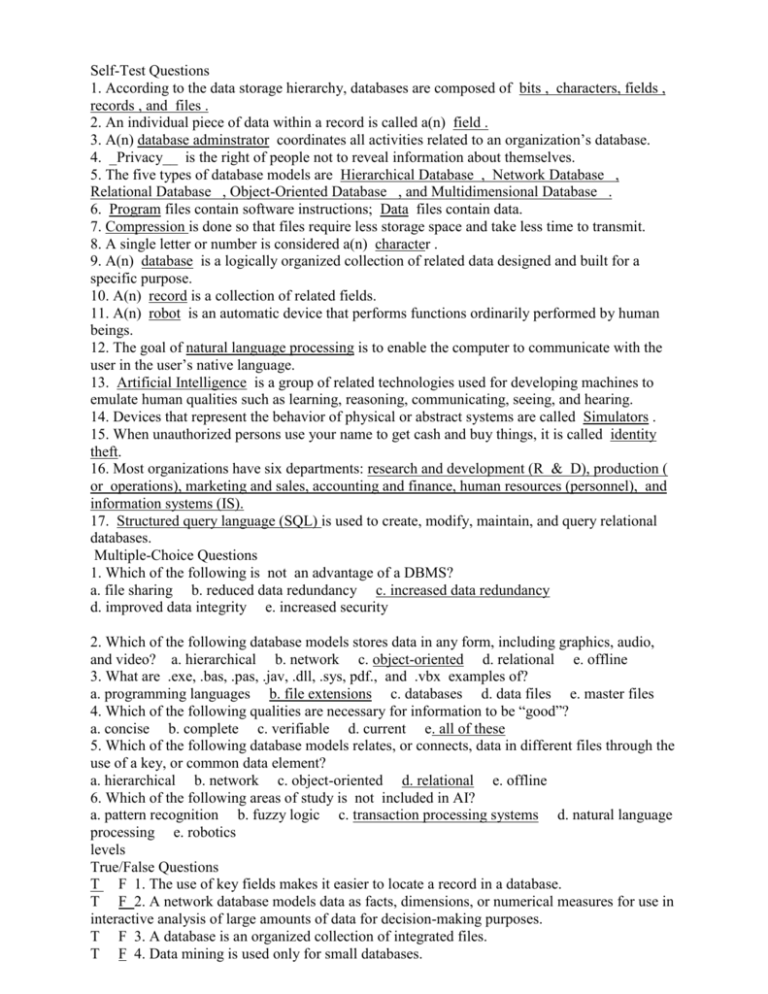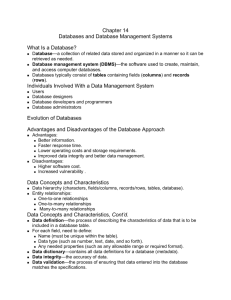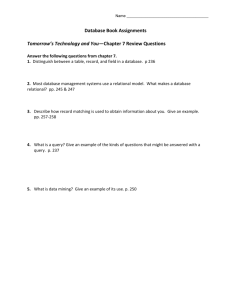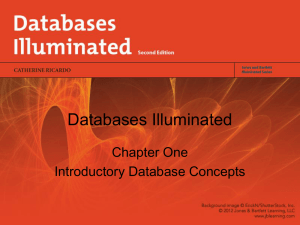Ch06
advertisement

Self-Test Questions 1. According to the data storage hierarchy, databases are composed of bits , characters, fields , records , and files . 2. An individual piece of data within a record is called a(n) field . 3. A(n) database adminstrator coordinates all activities related to an organization’s database. 4. _Privacy__ is the right of people not to reveal information about themselves. 5. The five types of database models are Hierarchical Database , Network Database , Relational Database , Object-Oriented Database , and Multidimensional Database . 6. Program files contain software instructions; Data files contain data. 7. Compression is done so that files require less storage space and take less time to transmit. 8. A single letter or number is considered a(n) character . 9. A(n) database is a logically organized collection of related data designed and built for a specific purpose. 10. A(n) record is a collection of related fields. 11. A(n) robot is an automatic device that performs functions ordinarily performed by human beings. 12. The goal of natural language processing is to enable the computer to communicate with the user in the user’s native language. 13. Artificial Intelligence is a group of related technologies used for developing machines to emulate human qualities such as learning, reasoning, communicating, seeing, and hearing. 14. Devices that represent the behavior of physical or abstract systems are called Simulators . 15. When unauthorized persons use your name to get cash and buy things, it is called identity theft. 16. Most organizations have six departments: research and development (R & D), production ( or operations), marketing and sales, accounting and finance, human resources (personnel), and information systems (IS). 17. Structured query language (SQL) is used to create, modify, maintain, and query relational databases. Multiple-Choice Questions 1. Which of the following is not an advantage of a DBMS? a. file sharing b. reduced data redundancy c. increased data redundancy d. improved data integrity e. increased security 2. Which of the following database models stores data in any form, including graphics, audio, and video? a. hierarchical b. network c. object-oriented d. relational e. offline 3. What are .exe, .bas, .pas, .jav, .dll, .sys, pdf., and .vbx examples of? a. programming languages b. file extensions c. databases d. data files e. master files 4. Which of the following qualities are necessary for information to be “good”? a. concise b. complete c. verifiable d. current e. all of these 5. Which of the following database models relates, or connects, data in different files through the use of a key, or common data element? a. hierarchical b. network c. object-oriented d. relational e. offline 6. Which of the following areas of study is not included in AI? a. pattern recognition b. fuzzy logic c. transaction processing systems d. natural language processing e. robotics levels True/False Questions T F 1. The use of key fields makes it easier to locate a record in a database. T F 2. A network database models data as facts, dimensions, or numerical measures for use in interactive analysis of large amounts of data for decision-making purposes. T F 3. A database is an organized collection of integrated files. T F 4. Data mining is used only for small databases. T F 5. A character is smaller than a field. T F 6. A report generator is a machine that produces electricity by calculating complex algorithms. T F 7. A data dictionary defines the basic organization of the database and contains a list of all files in the database. T F 8. Most types of storage media last indefinitely. T F 9. Expert systems are not interactive. T F 10. You need only software to create virtual reality. T F 11. A knowledge base is part of a natural language system. T F 12. Program files contain all the documents you have created. Short-Answer Questions 1. Name three responsibilities of a database administrator. 1) determine user access privileges; set standards, guidelines, and control procedures. 2) assist in establishing priorities for requests. 3) prioritize conflicting user needs. 4) develop user documentation and input procedures. 2. What is data mining? Data mining (DM) is the computer-assisted process of sifting through and analyzing vast amounts of data in order to extract hidden patterns and meaning and to discover new knowledge. 3. Briefly explain what a data warehouse is. A data warehouse is a special database of cleaned-up data and meta-data. 4. List four basic advantages provided by database management systems. 1. 2. 3. 4. 5. Reduced data redundancy (redundant data is stored in multiple places, which causes problems keeping all the copies current) Speed—Modern DBMSs are much faster than manual data-organization systems Improved data integrity—The data is accurate, consistent, and up to date Timeliness—The data can be supplied in a timely fashion—when people need it. Ease of sharing—The data in a database is usually shared over a network by an entire organization. 5. What is the difference between a data file and a program file? Unlike program files, data files don’t instruct the computer to do anything. Rather, data files are there to be acted on by program files. 6. What are expert systems used for? Expert systems are used by both management and nonmanagement personnel to solve specific problems, such as how to reduce production costs, improve workers’ productivity, or reduce environmental impact. 7. What is SQL? - Structured Query Language (SQL) : is a standard language used to create, modify, maintain, and query relational databases. 8. Explain e-commerce. e-commerce or electronic commerce, is the buying and selling of products and services through computer networks. There are types of E-Commerce • Business-to-Business (B2B) • A business sells to other businesses using the internet or a private network • Business-to-Consumer (B2C) • A business sells goods or services directly to consumers • Consumer-to-Consumer (C2C) • Consumers sell goods or services directly to other consumers with the help of a third party, such as eBay 11. What are intelligent agents used for? An intelligent agent is a form of software with built-in intelligence that monitors work patterns, asks questions, and performs work tasks on your behalf, such as roaming networks and compiling data, searching the internet and online databases for information and bring the results back to you. 12. What do you need to experience virtual reality? You need software and special headgear. 14. What are the four main areas of artificial intelligence? • • • • Expert systems Natural language processing Pattern recognition Robotics











